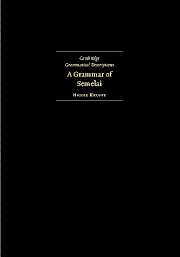Book contents
- Frontmatter
- Dedication
- Contents
- Tables and figures
- Preface
- Acknowledgements
- Abbreviations and conventions
- Maps
- 1 Semelai
- 2 Phonology and phonotactics
- 3 Morphology
- 4 Word classes
- 5 The verb
- 6 Pronouns: personal, ignorative, and demonstrative
- 7 The noun phrase
- 8 Prepositions and the prepositional phrase
- 9 Grammatical relations, constituent order and coding strategies
- 10 Basic clauses
- 11 Complex clauses
- 12 Expressives
- 13 The quotative marker, interjections and discourse clitics
- 14 Texts
- Vocabulary
- References
- Index
5 - The verb
Published online by Cambridge University Press: 05 November 2014
- Frontmatter
- Dedication
- Contents
- Tables and figures
- Preface
- Acknowledgements
- Abbreviations and conventions
- Maps
- 1 Semelai
- 2 Phonology and phonotactics
- 3 Morphology
- 4 Word classes
- 5 The verb
- 6 Pronouns: personal, ignorative, and demonstrative
- 7 The noun phrase
- 8 Prepositions and the prepositional phrase
- 9 Grammatical relations, constituent order and coding strategies
- 10 Basic clauses
- 11 Complex clauses
- 12 Expressives
- 13 The quotative marker, interjections and discourse clitics
- 14 Texts
- Vocabulary
- References
- Index
Summary
In Chapter 5 the categories that are marked morphologically on the verb are examined. Prior to discussing the functions of the morphemes, the structure of the verbal word is examined in §5.1. We then pass to a semantic classification of verbs in §5.2.
In Chapter 3 the structural processes of morphology were examined. The focus in this chapter is on the function of the derivational morphemes (§5.3 and §5.4), and verbal clitics (§5.5).
In §5.6 we diverge from categories marked morphologically on the verb, to a description of modal auxiliaries, treated systematically here on the basis of semantic category.
5.1 The structure of the verbal word
The structure of the verbal word is determined by whether the argument structure of the verb is intransitive or transitive (§5.2). Intransitive verbs are generally more simple in structural terms than transitive verbs, as there are fewer categorial distinctions available. In its simplest form the verbal word exists in the root form; at its most complex it may be host to a number of affixes and/or clitics.
Derivational affixes predominantly take the form of prefixes and infixes, but also include a suffix and a circumfix. These are immediately adjacent, located either on the left or right edge, or in the case of infixes, internal to the root. Peripheral to derivational morphemes are the proclitics.
- Type
- Chapter
- Information
- A Grammar of Semelai , pp. 105 - 169Publisher: Cambridge University PressPrint publication year: 2004



